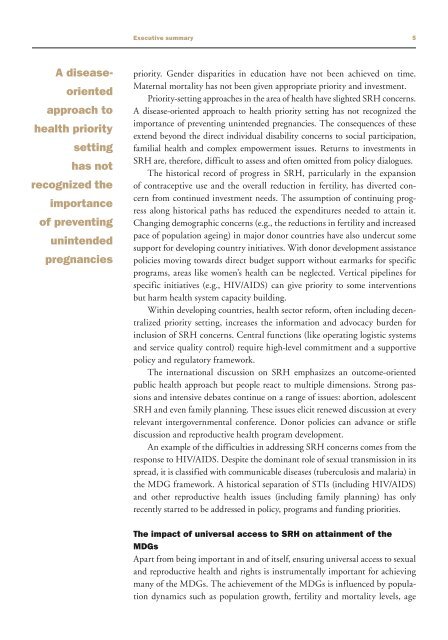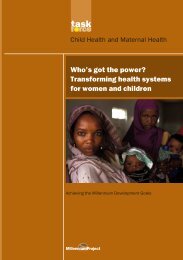Public Choices, Private Decisions: Sexual and Reproductive Health ...
Public Choices, Private Decisions: Sexual and Reproductive Health ...
Public Choices, Private Decisions: Sexual and Reproductive Health ...
You also want an ePaper? Increase the reach of your titles
YUMPU automatically turns print PDFs into web optimized ePapers that Google loves.
Executive summary<br />
5<br />
A diseaseoriented<br />
approach to<br />
health priority<br />
setting<br />
has not<br />
recognized the<br />
importance<br />
of preventing<br />
unintended<br />
pregnancies<br />
priority. Gender disparities in education have not been achieved on time.<br />
Maternal mortality has not been given appropriate priority <strong>and</strong> investment.<br />
Priority-setting approaches in the area of health have slighted SRH concerns.<br />
A disease-oriented approach to health priority setting has not recognized the<br />
importance of preventing unintended pregnancies. The consequences of these<br />
extend beyond the direct individual disability concerns to social participation,<br />
familial health <strong>and</strong> complex empowerment issues. Returns to investments in<br />
SRH are, therefore, difficult to assess <strong>and</strong> often omitted from policy dialogues.<br />
The historical record of progress in SRH, particularly in the expansion<br />
of contraceptive use <strong>and</strong> the overall reduction in fertility, has diverted concern<br />
from continued investment needs. The assumption of continuing progress<br />
along historical paths has reduced the expenditures needed to attain it.<br />
Changing demographic concerns (e.g., the reductions in fertility <strong>and</strong> increased<br />
pace of population ageing) in major donor countries have also undercut some<br />
support for developing country initiatives. With donor development assistance<br />
policies moving towards direct budget support without earmarks for specific<br />
programs, areas like women’s health can be neglected. Vertical pipelines for<br />
specific initiatives (e.g., HIV/AIDS) can give priority to some interventions<br />
but harm health system capacity building.<br />
Within developing countries, health sector reform, often including decentralized<br />
priority setting, increases the information <strong>and</strong> advocacy burden for<br />
inclusion of SRH concerns. Central functions (like operating logistic systems<br />
<strong>and</strong> service quality control) require high-level commitment <strong>and</strong> a supportive<br />
policy <strong>and</strong> regulatory framework.<br />
The international discussion on SRH emphasizes an outcome-oriented<br />
public health approach but people react to multiple dimensions. Strong passions<br />
<strong>and</strong> intensive debates continue on a range of issues: abortion, adolescent<br />
SRH <strong>and</strong> even family planning. These issues elicit renewed discussion at every<br />
relevant intergovernmental conference. Donor policies can advance or stifle<br />
discussion <strong>and</strong> reproductive health program development.<br />
An example of the difficulties in addressing SRH concerns comes from the<br />
response to HIV/AIDS. Despite the dominant role of sexual transmission in its<br />
spread, it is classified with communicable diseases (tuberculosis <strong>and</strong> malaria) in<br />
the MDG framework. A historical separation of STIs (including HIV/AIDS)<br />
<strong>and</strong> other reproductive health issues (including family planning) has only<br />
recently started to be addressed in policy, programs <strong>and</strong> funding priorities.<br />
The impact of universal access to SRH on attainment of the<br />
MDGs<br />
Apart from being important in <strong>and</strong> of itself, ensuring universal access to sexual<br />
<strong>and</strong> reproductive health <strong>and</strong> rights is instrumentally important for achieving<br />
many of the MDGs. The achievement of the MDGs is influenced by population<br />
dynamics such as population growth, fertility <strong>and</strong> mortality levels, age
















